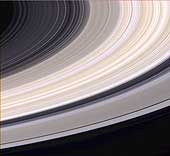|
COMETS EARTH JUPITER KUIPER BELT MARS MERCURY METEORITES NEPTUNE OORT CLOUD PLUTO SATURN SOLAR SYSTEM SPACE SUN URANUS VENUS ORDER PRINTS
PHOTO CATEGORIES SCIENCEVIEWS AMERICAN INDIAN AMPHIBIANS BIRDS BUGS FINE ART FOSSILS THE ISLANDS HISTORICAL PHOTOS MAMMALS OTHER PARKS PLANTS RELIGIOUS REPTILES SCIENCEVIEWS PRINTS
|
Related Documents
Download Options
Nine days before it entered orbit, Cassini spacecraft captured this exquisite natural color view of Saturn's rings. The images that make up this composition were obtained from Cassini's vantage point beneath the ring plane with the narrow angle camera on June 21, 2004, at a distance of 6.4 million kilometers (4 million miles) from Saturn. The image scale is 38 kilometers (23 miles) per pixel. The brightest part of the rings, curving from the upper right to the lower left in the image, is the B ring. Many bands throughout the B ring have a pronounced sandy color. Other color variations across the rings can be seen. Color variations in Saturn's rings have previously been seen in Voyager and Hubble Space Telescope images. Cassini's images show that color variations in the rings are more pronounced in this viewing geometry than they are when seen from Earth. Saturn's rings are made primarily of water ice. Since pure water ice is white, it is believed that different colors in the rings reflect different amounts of contamination by other materials such as rock or carbon compounds. In conjunction with information from other Cassini instruments, Cassini images will help scientists determine the composition of different parts of Saturn's ring system. |
